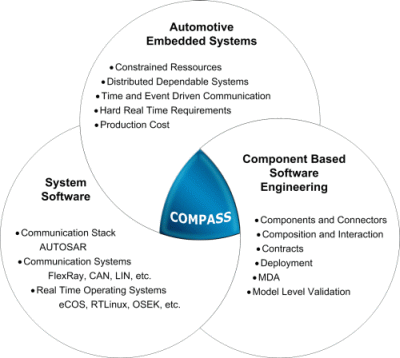Project mission and aims
The Mission: Today's vehicle networks are transforming automotive components into highly distributed, embedded dependable systems. Replacing rigid mechanical components with dynamically configurable electronic elements triggers an almost organic, system wide level of integration. COMPASS is intended to develop a component based hardware/software architecture to meet the requirements arising by future applications.

Scientific Aims: Define a component based hardware software infrastructure, metrics, and benchmarks to assess cost, performance and dependability aspects for an automotive application development:
- Trading of the following non-functional requirements against each other and against the design penalty introduced by the strict
modularity of the component paradigm:
- Performance
- Resource Usage (Cost)
- Dependability, especially maintainability and reliability
- Definition and identification of automotive application benchmarks and cost metrics as a guiding measure for the hardware/software partitioning process of components. Best practice rules and guidelines will be derived from the prototype implementations.
- Identification and definition of a composition and interaction standard for the deployment of components with the goal to:
- allow a seamless migration of a component implementation from hardware to software or vice versa
- allow an efficient implementation of the interfaces for a multitude of different hardware platforms
Technical Aims: Provide interchangeable hardware/software components for the communication subsystem.
- Identification of relevant functions (components) for the mapping for hardware/software partitioning in the framework of emerging standards and recent projects (EAST-EEA2, EASIS3, DECOS4, AUTOSAR)
- Definition of implementation independent component interfaces that allow an optimal hardware/ software partitioning
- Development of representative automotive application benchmarks and metrics
- Prototype implementations of software components and functional equivalent hardware IP modules, mainly under the aspect of the identified cost constraints
- Evaluation of the implemented hardware/software solutions with the use of our previously elaborated benchmarks and metrics (profiling)
- Demonstrator setup and experimental evaluation for a proof-of-concept
